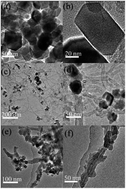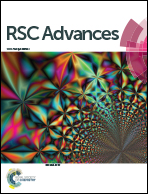Synthesis of poly(m-phenylenediamine)/iron oxide/acid oxidized multi-wall carbon nanotubes for removal of hexavalent chromium†
Abstract
Poly(m-phenylenediamine)-coated Fe3O4/o-MWCNTs nanoparticles (PmPD/Fe3O4/o-MWCNTs) were synthesized by one-step chemical oxidation polymerization. The materials were characterized by transmission electron microscopy, Fourier-transform infrared spectroscopy, X-ray diffraction, vibrating sample magnetometry, and Brunauer–Emmett–Teller surface area measurement. Hexavalent chromium adsorption by PmPD/Fe3O4/o-MWCNTs was found to be strongly dependent on the solution pH. The adsorption isotherm of Cr(VI) onto PmPD/Fe3O4/o-MWCNTs fitted the Langmuir isotherm model at different temperatures and the maximum adsorption capacity was determined to be 346 mg g−1. The adsorption process of different initial concentrations can be described by the pseudo-second-order kinetic model. The intraparticle diffusion study revealed that external mass transfer and intraparticle diffusion apparently influenced the overall rate process. The values of thermodynamic parameters indicated that the adsorption process was spontaneous and endothermic. In addition, the adsorption mechanism included both the physical and the chemical adsorption mechanisms. After adsorption, PmPD/Fe3O4/o-MWCNTs could be conveniently separated from the media by an external magnetic, and the adsorption capacity can remain at up to 52% after five times of usage. These results demonstrate that PmPD/Fe3O4/o-MWCNTs are a good candidate for the removal of Cr(VI) from aqueous solution.


 Please wait while we load your content...
Please wait while we load your content...